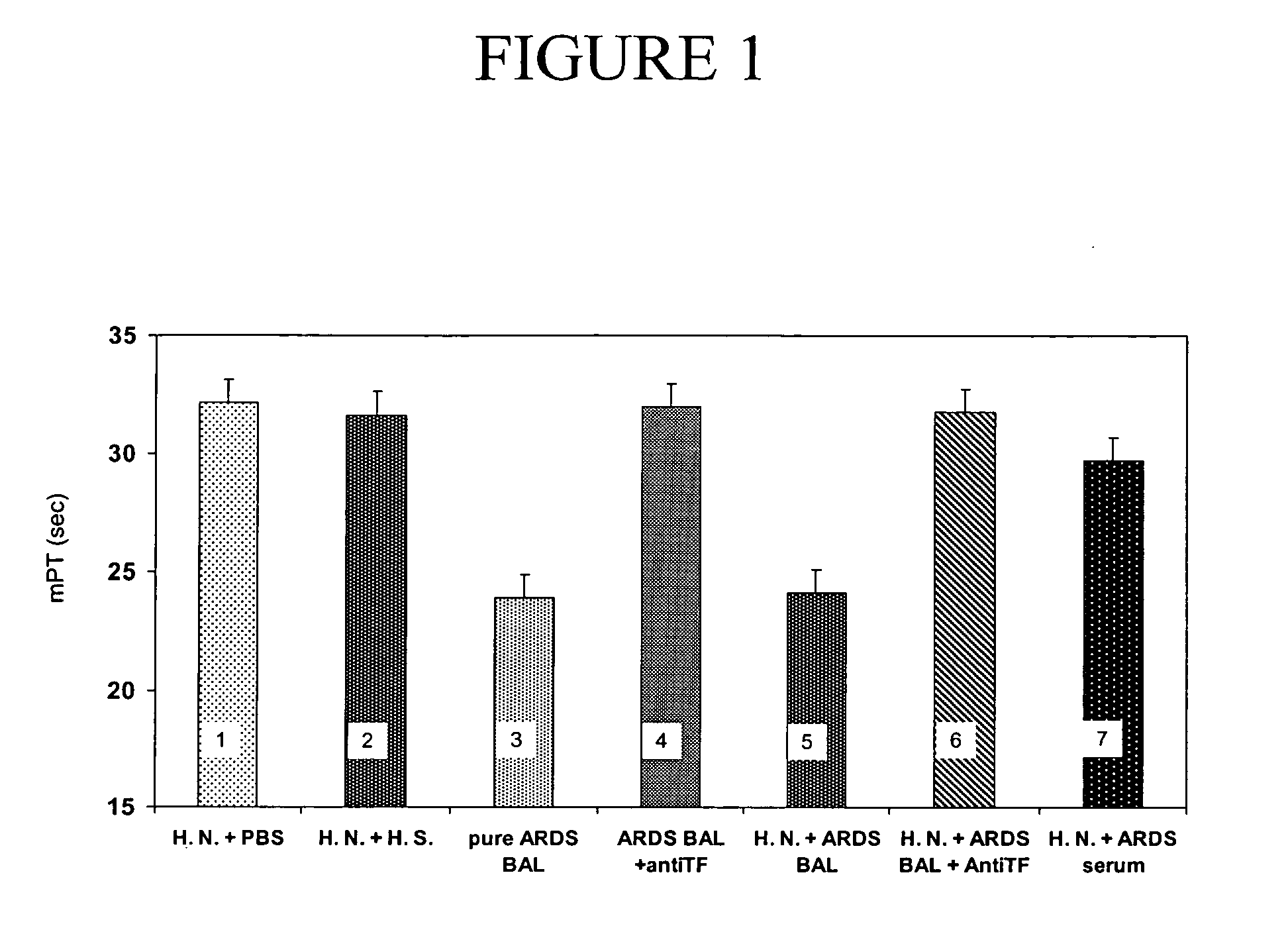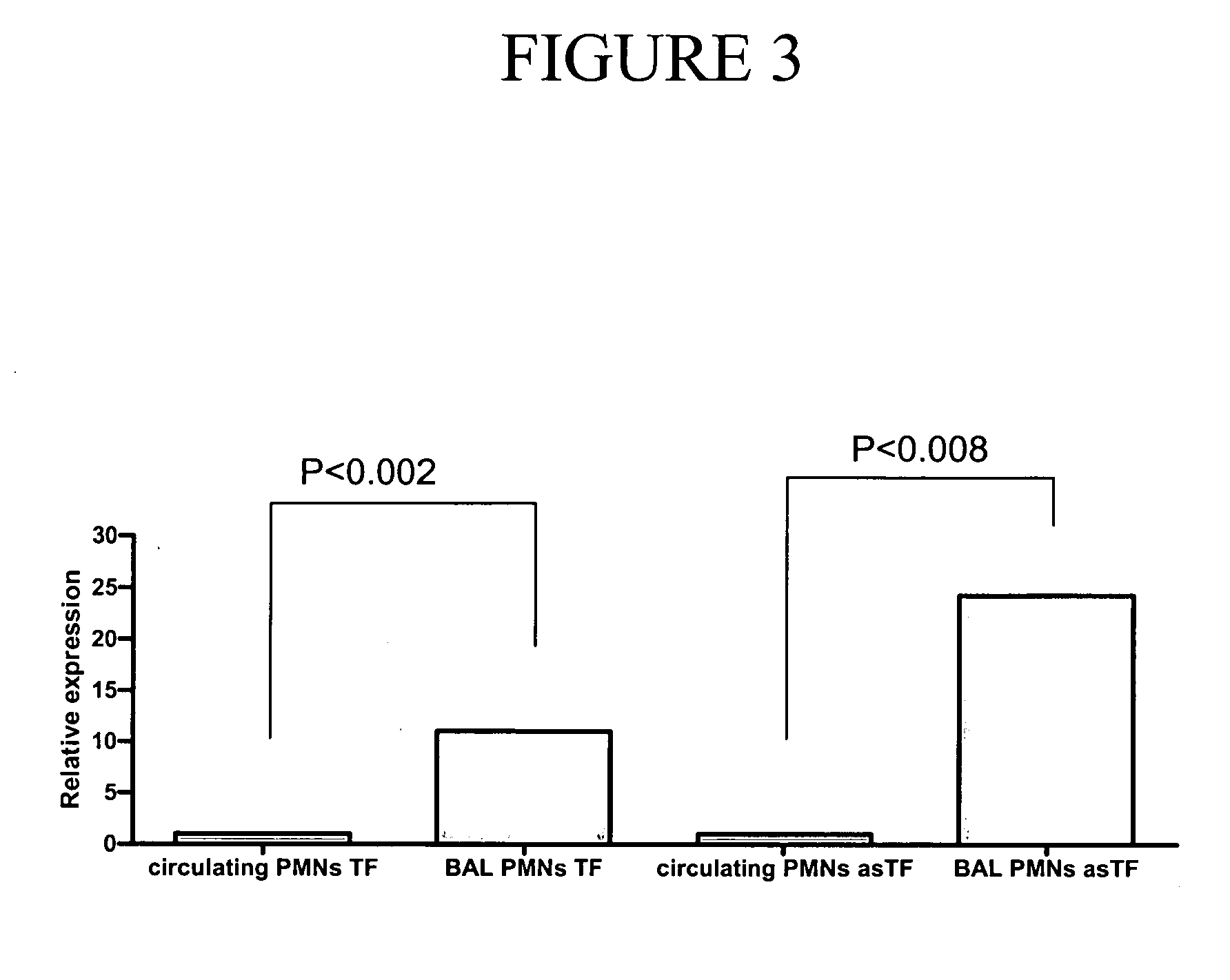Method Of Treating Acute Respiratory Distress Syndrome
- Summary
- Abstract
- Description
- Claims
- Application Information
AI Technical Summary
Benefits of technology
Problems solved by technology
Method used
Image
Examples
experimental example 1
BALF from ARDS Patients has Strong Pro-Coagulant Activity that is TF-Dependent+
[0113]To evaluate the pro-coagulant activity of BALF from ARDS patients, the mPTs of BALF supernatants obtained after centrifugation were measured. Preliminary experiments showed that the pro-coagulant activity of BALF was dose-dependent, reaching maximal levels when 150 μl of BALF was used for the assay; 40 μl of BALF had no effect on the mPTs, when compared to control values. For further experiments, a dose of 120 μl of BALF was used, since this amount of fluid induced significant shortening (p<0.001) of the mPT (23.91±1.30 sec; FIG. 1, bar 3) when compared to mPT of supernatants from neutrophils incubated with serum of healthy individuals (31.62±0.45 sec; FIG. 1, bar 2), or PBS alone (32.11±0.58 sec; FIG. 1, bar 1).
[0114]These assays further demonstrated that the pro-coagulant properties of BALF are dependent on the presence of functionally active TF, since pre-incubation of BALF supernatants with neut...
experimental example 2
Neutrophils Acccumulating in the Lumen of Pulmonary Alveoli in ARDS Patients are a Major Source of TF
[0115]Neutrophils constitute the major cellular population in the BALF from ARDS patients (Table 2). To test the hypothesis that neutrophils express TF within the alveoli of ARDS-affected lungs, the expression of TF in various cell types from the BALF of ARDS patients was characterized. Immunohistochemical staining of smears prepared from this fluid showed that >85% of neutrophils expressed TF in all seven analyzed samples, whereas no expression or only weak staining was observed on peripheral blood neutrophils from the same patients (FIG. 2A). Multinucleated giant cells showed positive cytoplasmic staining, mainly in two of the seven patients' samples (FIG. 2C, I). Alveolar macrophages were negative or exhibited only a very weak staining (FIG. 2C, II), whereas eosinophils and lymphocytes were negative.
TABLE 2BALF Cell CharacteristicsTotalAnalyzedCell Population (%)***BALFBALFAlveola...
experimental example 3
Mediators Present in Alveolar Fluid in Patients with ARDS Induce the Expression of TF in Neutrophils
[0118]The up-regulation of functionally active TF in alveolar neutrophils and the lack of such up-regulation in peripheral blood neutrophils suggest that these cells are stimulated to produce TF locally in the lumen of alveoli, or when they are crossing endothelial barrier or are present in the lung microcirculation. To test the first possibility, freshly isolated neutrophils from healthy donors were incubated with 40 μl of BALF supernatant from ARDS patients. This dose was selected because, as shown by our previous experiments, this amount of BALF did not result in a shortening of the mPT. Therefore, the residual amount of TF originating from the BALF used for neutrophil stimulation was not expected to interfere with the mPT assay, which used supernatants from activated neutrophils after stimulation. Indeed, supernatants isolated from BALF-activated neutrophils were observed to exert...
PUM
 Login to View More
Login to View More Abstract
Description
Claims
Application Information
 Login to View More
Login to View More - R&D
- Intellectual Property
- Life Sciences
- Materials
- Tech Scout
- Unparalleled Data Quality
- Higher Quality Content
- 60% Fewer Hallucinations
Browse by: Latest US Patents, China's latest patents, Technical Efficacy Thesaurus, Application Domain, Technology Topic, Popular Technical Reports.
© 2025 PatSnap. All rights reserved.Legal|Privacy policy|Modern Slavery Act Transparency Statement|Sitemap|About US| Contact US: help@patsnap.com



